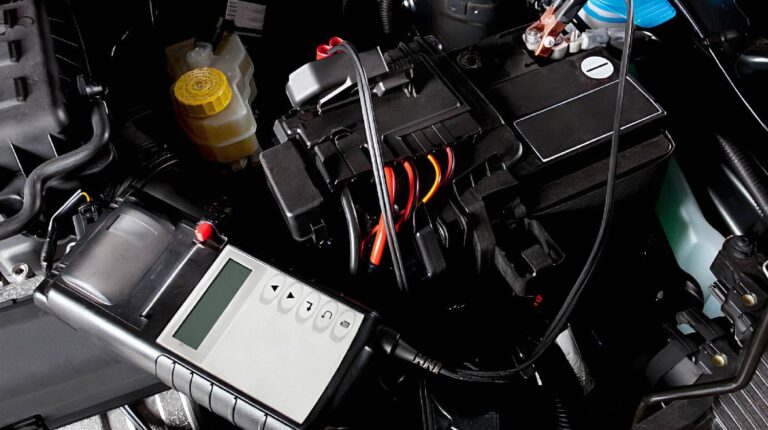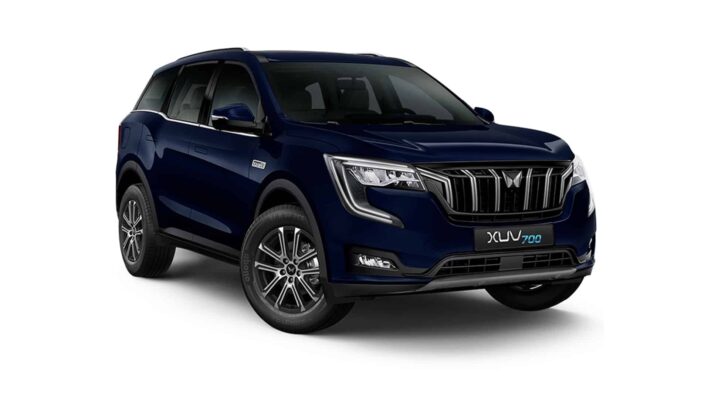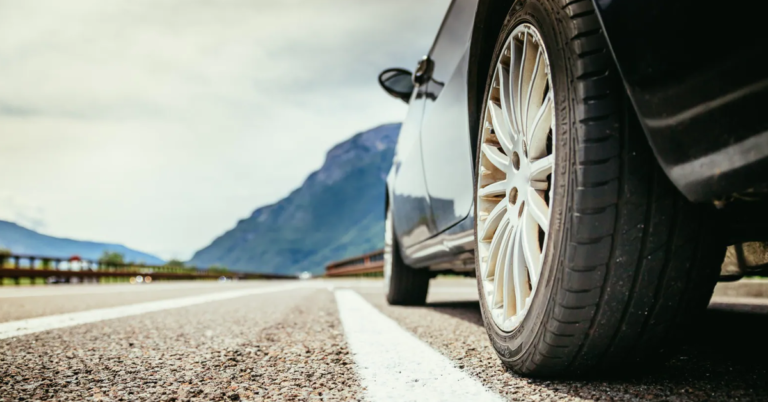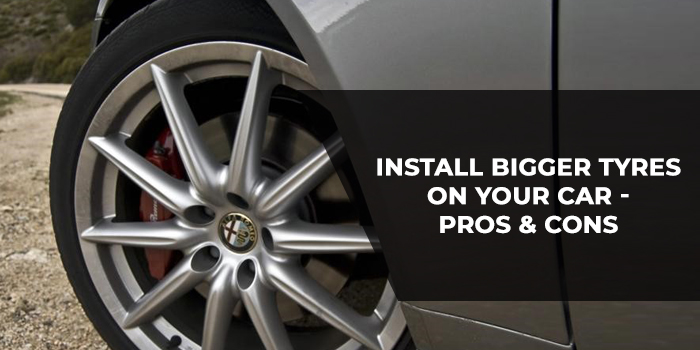
Tyres are responsible for transferring your vehicle’s engine power to the road, providing traction on slippery surfaces, allowing you to control the car around a corner and keeping the passengers comfortable with a soft ride. Bigger tyres have several benefits compared to low profile tyres such as increased performance, grip, long life and better ride and handling.
This article looks at the advantages and disadvantages of bigger tyres and helps you understand how different tyres make a difference to your driving experience. Choose the right tyre to maintain safety and optimum performance on the road.
What difference do bigger tyres make?
Bigger tyres give a vehicle a more aggressive look, extra stability and of course, they look cooler. On Indian roads, probably the best part of bigger tyres is that you are able to clear potholes and speed bumps without scraping the underneath of your car.

Before you install larger tyres, ensure that they will not interfere with suspension settings and that they fit well in the wheel arch. Bigger tyres can be more expensive, especially if you decide on alloy wheels, however, aluminium-magnesium materials are lighter and will save on the extra weight that you would potentially add to your vehicle.
An upgrade of 2 to 3 inches in wheel diameter should be ideal because anything more than that would look awkward and may not improve performance or instil confidence while driving. Ride and handling are also known to be softer with bigger tyres thanks to the cushioning effect of extra rubber.
Must read Tyre Construction: Its Parts and Their Function
The Pros and cons of bigger tyres
It is common to see vehicle owners upgrading their tyre size for reasons of performance, aesthetics and safety. Increasing the rim diameter by a couple of inches is usually acceptable and will not cause instability or adverse driving effects.
Let’s have a closer look at how bigger tyres can benefit you and also some of the disadvantages they bring.
Pros
Better traction – Larger tyres have more tread and rubber; therefore, they offer better grip on the road due to the higher contact patch. The car will be able to handle well. For example, cornering speeds will increase and there is less chance of hydroplaning or skidding with bigger tyres.
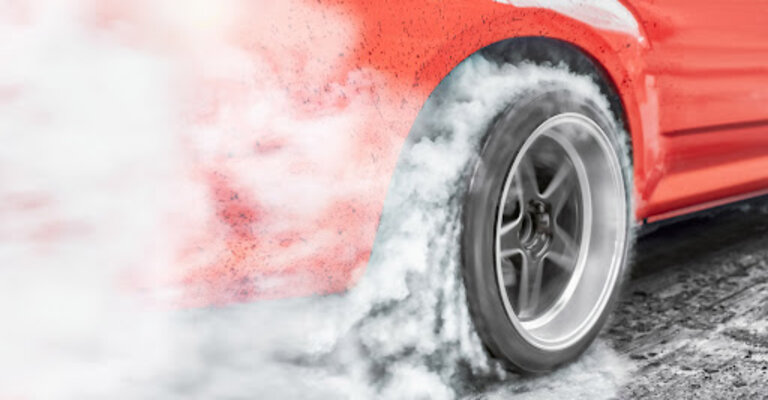
Bigger tyres will also have a wider, stiffer sidewall which will prevent flexing at high speeds and keep the vehicle stable through uneven surfaces. Overall, ride and handling are improved.
Shorter braking distance – Bigger tyres equal more rubber in contact with the road surface, which offers higher amounts of friction enabling the vehicle to stop at a shorter distance. The tread should not be too hard (this will not offer enough grip) or too soft (they will be sticky, but wear out sooner), a balanced compound that should improve braking performance.
Aesthetic appeal – Larger tyres are stylish and give the vehicle a premium look. The car receives a sporty look with bigger tyres as compared to low-profile tyres. Many SUVs are upgraded with bigger tyres purely to look better and add to the upright or tallboy stance.
Higher ground clearance – if you decide to go offroad in your vehicle, a bigger tyre set can add a few inches of ground clearance to help you clear steep climbs and rocky terrain. Even shallow bodies of water will be easier to cross with bigger tyres.
Must Checkout Different Types Of Tyre Tread Patterns
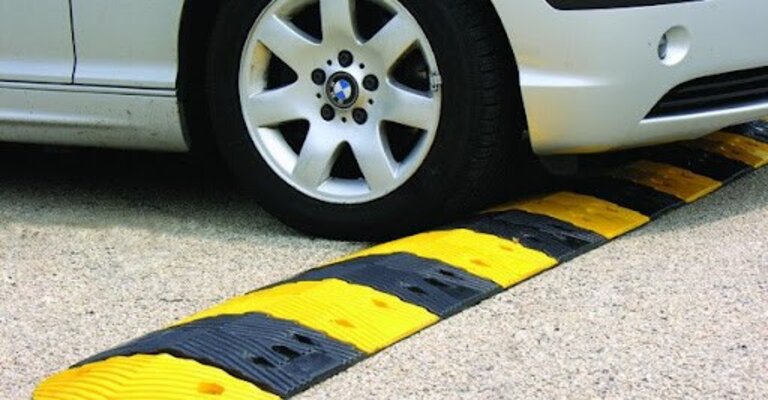
Cons
Decreased fuel economy – bigger tyres require bigger rims which equals more weight. This added weight will require more fuel to get the wheel rotating thereby decreasing fuel economy. The engine will also have to work harder during acceleration and high speeds leading to excess fuel consumption. If the engine is powerful enough, there may be only a negligible difference in fuel economy. Also, modern wheels can be made from light aluminium and magnesium alloys to keep the weight down.
Hard controls – drivers may feel that the steering is a little harder to turn due to the increased contact patch of the front tyres with the road. The added weight can also weigh down the steering at slow speeds.
Wear and tear – bigger tyres will wear out faster as they grip the road more efficiently. With a larger surface area in contact with the road surface, treads will wear down as you drive.
Inaccurate speedometer reading – The instrument cluster that measures distances covered and speed is calibrated to the standard wheel sizes that the vehicle is equipped with from the manufacturer. With bigger tyres, the calibration is disturbed which causes the speedometer to display a lower or higher speed.
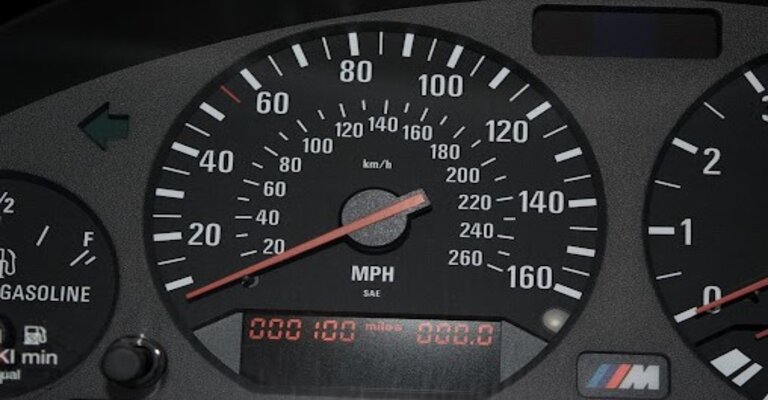
ABS, EBD or traction control – the electronic stability programs will not function properly because they have to deal with bigger tyres that have different parameters in terms of grip and speed.
Also read Retreading Tires : Is It Safe For Your Vehicle?
Conclusion
Car owners often don’t think about their tyre size and the advantages a bigger tyre has. It is more than just a cosmetic upgrade. Bigger tyres have more grip, provide better control, make the ride more comfortable and are safer than low-profile tyres.
Bigger wheels also mean you will have to spend more money on them, and replacement costs will also be higher when it comes time to change a worn-out tyre. Not all tyre sizes are compatible with every vehicle, and it is helpful to test the bigger tyre before installing it on your daily driver.
It is important to replace all 4 wheels with the same tyre size because the dynamics of the vehicle will be disturbed with different sizes on the front and rear.
Wheels and tyres are important components that affect your driving experience and safety. Choose the right tyre size for your vehicle and ensure you are getting the best levels of traction and keeping the passengers safe at the same time.
We hope you found this article on bigger tyres useful, as it should help you make a decision on upgrading your ride. Check out some of our other blogs such as Pick Up The Right Car Tyre and Methods to Reduce Tyre Noise While Driving or visit Carorbis Blog for more.
Frequently Asked Questions
Q1. Are bigger tires better?
Ans. Bigger tires improve the handling and high-speed performance of your vehicle. As compared to low profile tires, larger diameter tires are less noisy and have a softer, supple ride. The only downside is the additional weight of larger tires and rims. Bigger wheels and tires are good for increased traction. If you are going off-road, bigger tires can be really helpful because there is less chance of sinking in the sand and mud. Handling is better with big tires because there is a larger area of contact with the road surface, resulting in higher levels of grip.
Q2. How do I know which tire is bigger?
Ans. Bigger tires mean better grip on the road because as the tire contact patch increases, it covers more surface area and offers more traction. It may be difficult to differentiate between tire sizes just by looking at them. However, there is a way to read tire sizes by inspecting the tire wall. You may have read specs like 180 / 65 R15. On the left-hand side of the slash symbol, you will find the tire width in millimetres. In this case, the tire is 180 mm wide from sidewall to sidewall. The number on the right-hand side of the slash indicates the aspect ratio (the ratio of the height to the width) which is 65% in this case. The last specification. R15 is the rim size (which is a 15-inch diameter wheel).
Q3. Do bigger tyres increase fuel consumption?
Ans. Tyres with a larger diameter increase fuel consumption simply because they are heavier than smaller tyres. Bigger tyres will also have a larger contact surface area with the road which will increase their rolling resistance and require more fuel to get them moving. The difference will be noticeable in city driving due to short distances and the effect of stop-and-go traffic which needs constant acceleration and braking. On the highway, at high speeds, the difference will be negligible.
Q4. Do bigger tires affect speed?
Ans. Bigger tires will give the vehicle better handling and cornering speed. However, acceleration will be slower due to the heavier weight of bigger tires. The car’s engine will find it more difficult to rotate bigger wheels resulting in slower speeds and acceleration. Another effect of bigger tires is that the speedometer will be inaccurate. This is because the speedometer is calibrated to the OEM tire and changes in diameter will cause the instrumentation to display a slower speed than the vehicle is travelling at. If your car is equipped with a digital system and ECU, this may cause inaccuracies in all readings including fuel economy, tyre pressure and distance travelled.
Q5. Can you put bigger tyres on your car?
Ans. Installing bigger tyres on your car can be useful if you plan to go off-road because it adds a few inches of ground clearance, allowing you to traverse steep climbs and rocky terrain. Before installing bigger tires, check if they will rub against the inner wheel arch when the suspension bottoms out. Rim sizes can be increased by a few inches without a problem and many drivers replace their standard wheels with rims that are 1 or 2 inches bigger in diameter. The only disadvantage is the bigger tire is a little heavier and will cause a decrease in acceleration, and speed and may cause inaccuracies in speedometer and odometer readings.
Q6. Are bigger tyres better in sand?
Ans. Larger tyres are beneficial while driving in the sand because they can be run with a lower pressure without affecting the tyre width too much. Bigger diameter tyres can also roll through deep sand without sinking, they have a flatter surface area in contact with the terrain. Drivers often let out some air from tyres before venturing through sandy terrain so that they can get more traction on the loose surface, and bigger tyres are well suited for this procedure. There is less chance of getting stuck in the sand with bigger tyres due to their superior grip compared to smaller tyres. 4-wheel drive SUVs usually have wheels with a 16-inch diameter or more which is ideal for off-road conditions.
Also read Have A Smooth Ride If You Know How Often To Fill Air In Tyre
Q7. Do bigger tyres last longer?
Ans. Bigger tyres are known to last longer than smaller tyres. Larger tyres have more stability and offer greater traction which results in less wear and tear on the tyre treads. Chances of hydroplaning, which is when tyres skid over the surface of the water, are less likely with bigger tyres. With a larger amount of rubber and tread, a bigger tyre will take longer to wear out and will last significantly longer than low-profile tyres. Not all vehicles can be fitted with bigger tyres. Some models have restricted wheel arches and will not fit larger tyres so make sure that bigger wheels are suitable for your car.
Q8. Are bigger tires safer?
Ans. Bigger tyres offer more stability, control and ride comfort while driving at high speeds. They provide more grip and traction around corners reducing the chances of the car losing control and drifting off the road. There is a decreased chance of wheels spinning under hard acceleration and braking distances are shortened as well. The suspension also gets more travel with larger tyres which can aid in stability, especially over rough roads. If you travel over broken tarmac, potholes or speed bumps, you may have noticed that larger wheels can cope with uneven surfaces better than smaller tyres. For example, scooters with small wheels lose control more often than motorcycles that have larger-diameter wheels. Hydroplaning is also less likely to occur due to the larger wheels’ greater surface area in contact with the wet road.
Q9. Advantages of bigger tyres in cars?
Ans. The top benefits of bigger tyre size on cars include better grip and traction, generally bigger tyres are wider and have more tread in contact with the road. Handling of the car is improved through enhanced road holding and drivers may notice that corner speeds are higher with more stability. At high speeds, the vehicle will have more control due to a planted stance much like an SUV. The car will be able to brake much more effectively due to the higher grip levels. There is less chance of the tyres skidding or slipping on low friction surfaces. The oversteer and understeer nature inherent in some vehicles can be eliminated with bigger tyre sizes, making the drive safer. Passengers may notice is a supple and soft ride that is cushioned thanks to more rubber between the car and the road. Finally, larger tyres look quite cool and add an aesthetic appeal to the ride.
Also Checkout Find Out All About The Process Of Tire Regrooving In Detail


